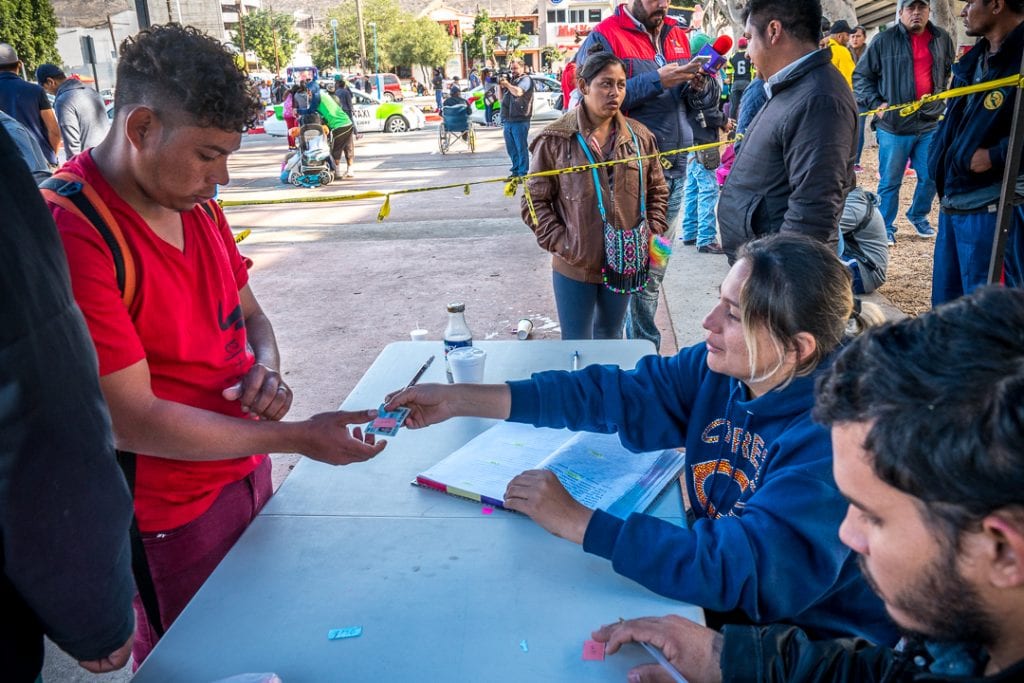The List All Caravan Asylum Seekers Want to Be On
By Ken Alexander*

HAVANA TIMES – Within the coming days, a total of 8,000 Central American asylum seekers are expected to have reached the Mexican side of the border with the USA, in Tijuana. Over 6,000 have already arrived.
On the other side of the border, over 5,000 US Troops – around 2 for every 3 migrants – have been deployed with the latest high-tech gear. The Border Patrol also has high powered rifles, powerful vehicles and night vision.
For Mexican and US citizens who drive across the border into the US your car is x-rayed, your documents photographed, and everything analyzed by computers before you even reach the guard station 50 yards head. And, cameras and ground sensors line the U.S. side of the border relaying information instantly to command centers.
Who keeps the list?
However, the process of managing who will be able to request asylum, and when, is all done in a very neatly organized notebook where each name is hand written. The names are grouped by tens and assigned a number. That number is then written on a very small piece of paper and given to each person in that group. It is the key to the highway and it is low-tech all the way.
US Immigration does not manage the list. And the Mexican border patrol does not manage it either. It is managed by a small group of migrants and kept safe by the Mexican authorities at night. There is just this one hand written copy of the book.

Immigration asks the keepers of the list who is next to be processed. It is a very democratic process. The group of migrants who manage the list was elected in a manner so that they would represent each of the countries from which the migrants had come; El Salvador, Honduras, Guatemala and Nicaragua.
The process works the same at the border in Nogales, MX, about eight hours east of Tijuana. Volunteer groups manage who is on the list and make sure that the migrants get to US Immigration when their number comes up. In Tijuana, it is much more complicated because of the enormous number of people. Communication is very difficult in the camps here in Tijuana.
Many of the migrants that I interviewed over the past two weeks did not know about the list and about the need to get a number. They arrived and received a wrist band with a number on it. It all seemed official. No one told them there was another step; a critical one. Simply arriving at the camp was not going to get you an asylum interview.
It was heartbreaking to inform many of migrants who had been camped out in Tijuana for weeks that they still needed to get a number. It was difficult to learn that while they had settled into the increasingly squalid conditions of the Benito Juarez sports facility, hundreds and thousands of arriving migrants did get on the list ahead of them.
In order to get on the list you have to walk 30 minutes or so to the Chaparral border crossing; the scene of the border rush last week. Under a tent, on a folding table sits the notebook. Your name gets written in it along with your country of origin, and you get your number.
The difficult part is that you have to be back at this border crossing at 6:30 am the morning that your number is called. And that may be months from now. With thousands of people on the list, and the U.S. processing no more than 100 people per day, it is very difficult to know when to come to the border. And if you miss your day, you have only 24 hours in which to come back and explain.
After that your name goes to the bottom of the list.
Now that the migrants are moving to a new facility 15 miles away from the Juarez Benito camp, the effort to get to the Chaparral border crossing to register, or to listen for your number to be called, will be arduous. It is a waiting game, and a confusing one at that.
*Ken Alexander is a freelance photographer and journalist from Woods Hole, MA, USA. He can be reached at [email protected].
Also Read: Hopes, Art & Tension at the US Border in Tijuana






I think it is worth noting that the problems of the migrants are not a consequence of actions by the USA. They are a consequence of the incompetent administrations of their countries of origin.
To the migrants, the USA is a potential haven where they hope to be able to gain employment, enjoy a good standard of living and bring up their children with sound education and much less danger.
That is what they have been unable to achieve in their own countries reflecting the failure of their own governments – whatever their political persuasion.
There has been much promotion of a few Venezuelans returning to Venezuela under a Maduro program. But what is the percentage returning, as some two million were reported to have left?